Long Live the Dream
An oral history of the "Five Years Later" run of the Legion of Super-Heroes.
I had never read a Legion of Super-Heroes comic before stumbling upon its Five Years Later run, which imagines the book’s core cast of idealistic young superheroes from across the universe each on their own and struggling with the issues of a much darker galaxy. It was Keith Giffen’s spooky cover art that grabbed me: a man in a trench coat standing amidst ruins, his face hidden in shadow, a golden ring in the dirt. I didn’t know what it meant. I didn’t know that a comic book could look like that.
I had to know more.
In many ways, that cover captured the magic of Five Years Later. As helmed by Giffen and co-plotted by himself, inker Al Gordon and dialogue writers Tom and Mary Bierbaum from 1989 to 1992, Five Years Later constantly defied conventions and readers’ immediate understanding, in search of what might be found further, later, deeper. It was a book that at times refused to introduce its characters; a superhero comic that eschewed costumes or code names; a series that did the hard yards developing its ideas only to sometimes suddenly (and literally) blow them up; a tale filled with horrors that nevertheless was always a story about hope.
Five Years Later was loved by some and vilified by others, and remains so to this day. And while its influence can be seen in so many contemporary titles, its own characters and universe have been entirely erased from DC continuity.
This is the story of a generous, restless genius; a fast talking but tender-hearted rascal; an earnest husband and wife who thrived on puzzles; and the team of talented, tough and funny people with whom they gathered to chase a dream, one of hope in a complex and often dark universe. It’s also the story of a comic book about much the same.
And it begins, as comic book stories often do, with an artist who had had enough.

Keith Giffen (creator and penciller): I did that fucking Legion poster. I’d drawn the Legion lots of times. 1 And (in 1983) DC asked me to do a poster. I decided, I’m going to put every single character that’s ever appeared in the Legion of Super-Heroes. It was hundreds of figures. You’d open it up, and it was just massive, an elongated picture with all these figures. (When it was done) I said, “I can’t do this anymore. I have to get off this book.”
I think that poster had a lot to do with why I had to do to the Legion the way I did it. If I would’ve have had to go back to, “Oh there’s Rokk, and he’s got magnetic powers, and his girlfriend is Night Girl,” I think I’d have gone insane.
Giffen would leave Legion and go on to co-create the 1987 smash hit Justice League reboot that turned every bit of conventional wisdom about superhero team comics on its head. But a few years later, he returned to Legion as penciller and co-plotter. Then Levitz announced he was leaving the title to become publisher of the company.
Giffen: I had come back onto the Legion to work with Paul again. And I said “Jeez, I could just take over.” I was coming off of Justice League and looking for something different.
Al Gordon (co-plotter/inker): At this point Keith was like the Godfather at DC. He turned the Justice League from the worst selling book at DC to its bestselling book.
Mark Waid (Five Years Later’s initial editor): Keith, Mark DeMatteis 2 and Kevin Maguire’s Justice League launch was a huge bombastic thing for DC. So when Paul left Legion and Keith said “I want to do it solo,” everyone thought it would be a great idea.
Giffen: I said I’m going to jump the book five years. This way Paul’s run on the book will remain Paul’s run on the book. I went into the book determined to keep his run, which was so incredible, inviolate.
With Giffen on board as writer and penciller, a creative team began to form.
Waid: I was a huge fan of the Legion. I’d edited the “Who’s Who in the Legion of Super-Heroes” and also written three-quarters of it. (When) Paul was getting ready to step down, (then editor) Karen Berger thought this would be a good time for her to get out too, but I was the only person on the staff who loved the Legion enough to want to edit the book. So I kind of inherited it by dint of the fact that I was the only guy who was interested.
Giffen: Al Gordon and I had worked together before and I liked the way Al worked with my pencils. Tom and Mary Bierbaum I knew from Interlac. 3 Tom was a professional writer, but also they both knew the Legion inside out. And they had a really deep affection for the characters.
Tom Bierbaum (co-plotter/dialogue): Mary was a general comics fan who was within Legion fandom. I got involved in Legion fandom in the ’70s as it was really organizing. I got recruited by somebody at college who saw me reference Tenzil Kem (Matter-Eater Lad) in my school’s newspaper.
In the early 1980s Mary and I started pursuing writing and submitting to comic companies and so forth independent of our Legion interests. When Keith noticed we were trying to break in, he showed an interest in working with us. We were the luckiest people on the planet, obviously.
Giffen would recruit the Bierbaums to co-write the short-lived Deluxe Comics series Wally Wood’s T.H.U.N.D.E.R. Agents with him. He then asked them to join him on Legion.
T. Bierbaum: I was covering some event for Variety, and somebody forwarded me a message to call my wife. I thought something terrible had happened. And she asked, “Would we be interested in working with Keith on the Legion?” I couldn’t believe it. It had never crossed our minds that we would get the chance to do this.
Giffen: I thought “Okay, these are people I know, these are people I can work with. Also, their reactions to things will be a sort of red flag for me if I’m going too far.”
Waid: Keith brought up the idea of hiring Tom and Mary, who I knew from Legion fandom as really good people. If anyone knew as much about the Legion as I did, it was them. It was a harder sell at DC. They were unknowns to the people at DC and they had not done much comics writing. But Keith backed them 100%, and Tom and Mary were aboard.
Tom McCraw (colorist): I was just starting to work at DC Comics at the time. I was offered the coloring assignment because they were looking for someone new. I was a Legion fan before even getting the assignment, so I was a major fan of the work.
Waid: Todd Klein came on the team as letterer because he’s the best. I don’t know who asked for him, whether it was me or Keith, but it didn’t matter, one of us would have wanted him.
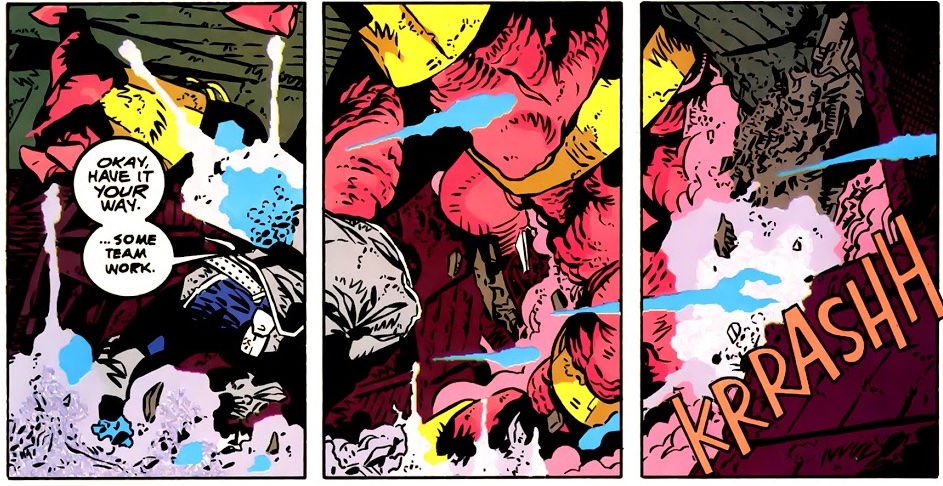
From the beginning Keith proposed a dramatic re-envisioning of the Legion in everything from cast to style of art.
Giffen: I wanted to radically alter the way you viewed the Legion, while not invalidating anything that has gone before.
T. Bierbaum: I think the first thing Keith said was we’re not going to use code names. It was like, “Whoa.” It’s one thing to remember that Clark is Superman. It’s another to remember that Rokk is Cosmic Boy or Garth is Lightning Lad.
Giffen: There were certain things that just didn’t translate. The whole idea of a clubhouse does not translate to today’s audience. They’d stand around and salute the flag, for God’s sake. We had flight rings. Flight rings. They used to drive me crazy.
Gordon: Keith asked, “How many aliens from other planets dress up like American Indians?” How does that come about? (Dawnstar’s) like a cross between Olivia Newton-John and a Navajo.
Giffen: For me, the Legion has always been a book about hope. The Legion was the positive future book. Aside from the threats that came along, it was basically a happy future.
My original idea was I’ll disband the Legion, and then I’ll tell the story of how they pull together. I’m going to carve the bottom out of the Legion, show each Legionnaire at their nadir. Their main reason for being is gone. Where did they go? What did they do? A lot can happen in five years.
T. Bierbaum: From probably the very first sentence out of Keith’s mouth we knew that this was going to be ambitious and challenging.
Giffen: I wanted to take a dystopian future and transform it into the Legion’s positive future.
For its core cast, Giffen chose Reep Daggle (Chameleon Boy); a war-wounded Rokk Krinn (Cosmic Boy); and Jo Nah (Ultra Boy), now a Robin Hood-type smuggler with a crew of his own. Meanwhile, their charismatic former teammate Dirk Morgna (Sun Boy) has become the spokesperson for an Earth government secretly controlled by the alien Dominators.
Giffen: I chose Reep because he was really into the Legion. He had a sense of history; he knew it was a good thing.
Cosmic Boy was my favorite Legionnaire. He wasn’t the typical comic book character. He wasn’t yearning after the girl he was afraid to talk to, he didn’t play into that morbid edge that most superheroes have. He liked the Legion, he stood up for the Legion, he was a happy guy. (But) I wanted a trauma in there, I wanted something that had occurred in his life that would have blown most of us off our pins.
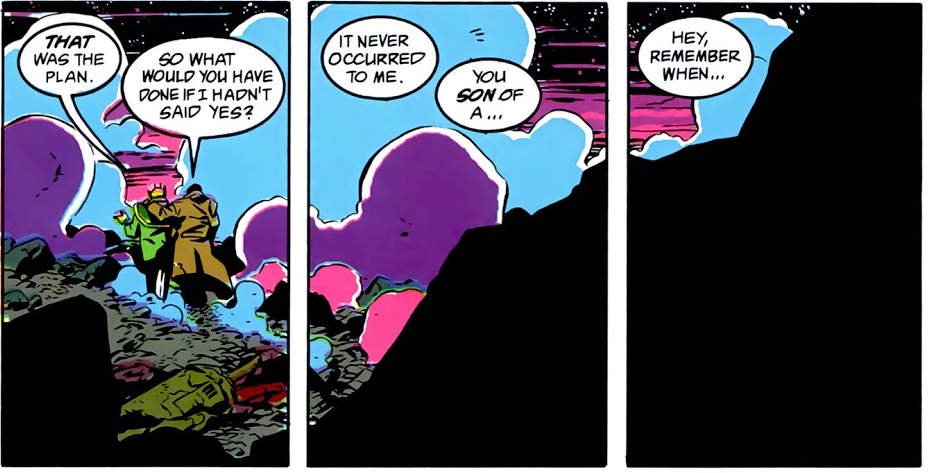
As we meet Rokk, he’s lost his powers and is trying to get his pregnant wife Lydda (Night Girl) to leave their now decimated and occupied planet.
Giffen: (I loved) removing his powers and showing that Rokk Krinn would still be a hero. Most of the Legionnaires, their powers were the least interesting thing to me. Rokk had no powers and he was making a difference.
T. Bierbaum: Al Gordon was on the team ahead of us by quite a bit, and he and Keith did a lot of brainstorming. I believe when Keith was wondering what they should do with Jo, Al literally said he should be like Han Solo.
Gordon: I think Jo is cooler than Han Solo. If he’s Han Solo, he’s Han Solo in Star Wars and not the other movies. In my mind Jo’s the guy that doesn’t want anyone to know that he’s actually the most moral son of a bitch around. To me he is the center, the heart and soul of the Legion.
Giffen: I don’t think the fans have ever forgiven me for what I did to Sun Boy. But look at his path, look at his history with the Legion. To me, it was the next logical step. We are the sum total of every decision we have made in our lives. I tried to play it like that. 4
Gordon: The cool thing about Keith is he wanted everyone involved. We used to call him the Father Confessor, because if you had an idea you called Keith and just talked it through with him.
Giffen: At one point I turned to Tom and Mary and Al and the other creatives on the book and said, “Tell you what, everyone create two characters and I’ll bring them into the Legion.” So Al came up with Kent Shakespeare and Celeste Rockfish, Tom and Mary came up with Kono (and Devlin O’Ryan). 5
T. Bierbaum: He said it like an assignment. “This is all fun, but something you need to do is you need to create a character.” Oh no, Keith, not that!
Giffen: Let’s face it, the Legion has always been a bitch to hold artists on, because you can’t just get a photograph of the Empire State Building and work off of that. You have to make it all up from scratch.
So I figured, give people working on the book a reason to want to be on the book. And DC was using a royalty system again, so you could create some characters and if they take off somewhere you can make some extra money.
T. Bierbaum: Keith worked so hard to give important roles to the characters that we added into the mix. Meanwhile the characters that he was adding, he was happy to let stay in the background.
Gordon: I especially loved Kono, who Mary created…I always read her scenes slower.
Mary Bierbaum (co-plotter/dialogue): I wanted to do a female character who was feisty and kind of aggressive and rough-edged. 6
T. Bierbaum: Mary injected a female assertiveness to the mix to a degree that you didn’t see a lot of earlier in the Legion’s run. We got close to a 50/50 mix of male and female characters, and Mary’s presence on the creative team was a part of that. We were also at that point trying to start a family. The fact that Laurel had a baby, that Garth and Imra were having another set of twins, that was the stage of life we were at. And (those ideas) were initiated by Mary.
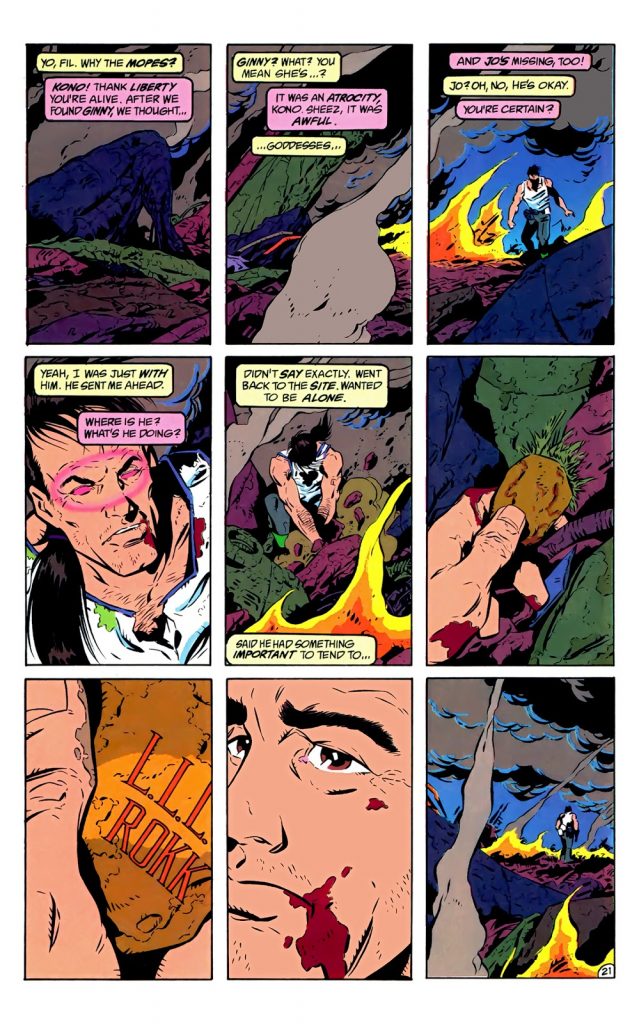
One of the most distinctive elements of the run would be its commitment to a nine-panel grid.
Giffen: I didn’t go in knowing I was going to do nine panel grids, it happened when I started drawing the book. I was just fascinated by the way Watchmen was laid out. I thought, “I want to play in that playground.”
T. Bierbaum: We really liked it because you could tell a lot of story. If you only have three panels per page, it’s hard to do much back and forth. It really facilitated more inventive dialogue.
I also think it communicated a claustrophobic feel that was integral to the universe Keith was depicting and to the way this Legion universe was different than the other ones. We’re in an era that is darker.
Waid: Keith had drawn his line in the sand there. That’s what he wanted to do. I thought it was crazy. (laughing)
Giffen: It was a way of doing pure storytelling. I thought, if I have a standard grid, it forces me to really focus on the storytelling. I won’t have the opportunity to say, “This is going in a weird direction, so I’ll do a two-thirds shot and a big spectacular piece of art, and everyone will go ‘Ooh,’” and I’ll be able to sneak onto something else.
Waid: The editorial challenge was this: Tom and Mary are very good writers, but they were brand new. And the cardinal sin of all brand new comics writers, including myself when I started out, was that you have no idea how much fits on a page, so you’re constantly writing scripts where there’s way too many panels on a page and way too much happening in every panel.
So I’m dealing with that and then we have to do it in nine panels on every page? A lot of it as I remember was getting through a script and going, “Okay, this is a fine script, but I have no idea how this could possibly fit.”
John Workman (letterer): Luckily, the writing was such that the lettering didn’t overpower the artwork. So I didn’t have to worry too much about covering things. I didn’t always know who the characters were; there were so many of them I kind of got lost. But they always provided a Xerox of the penciled artwork with indications of where the balloons go so I knew who was talking. That worked out well. 7
McCraw: The nine-panel grid could be time consuming, but I also liked the difference in style for the book. Keith got clever at times, changing things up, such as linking panels.
Gordon: There were a couple scenes where I convinced Keith to do a shot that really goes through three panels. It’s like if you set your camera down and opened the aperture in the dark and put a strobe light on…(There’s) this great shot of a character–he’s in the third panel and the other panels are part of the same background, which gives the impression that he is being thrown through all three panels.
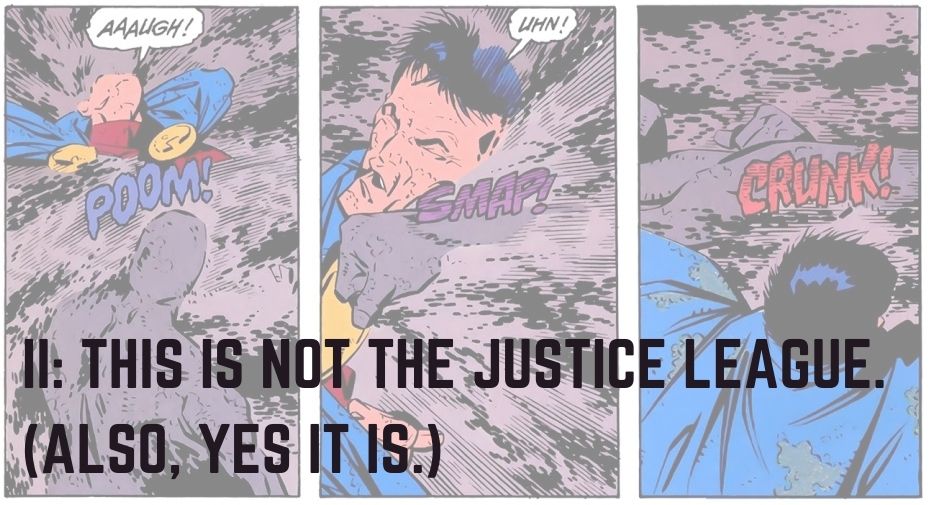
Waid: The excitement at DC was so high at that time that we were going to do three books – we were going to do Legion, and we were going to launch Legion Academy, and we were going to launch a third Legion book – (and) the idea was to roll them out, like August, September, October, Boom Boom Boom. That was the faith that DC had in Keith. You look at (what Keith did with) Justice League; how could this possibly fail?
Then the first issue came in art and lettered and went around the offices for people to read, and the air went out of that balloon immediately. Immediately. I thought it was great, but the universal opinion was, “I can’t understand this. This is not the Legion I know. What have you done?”
T. Bierbaum: I think there was always a kind of implicit understanding that the approach was taking a lot of risks. If you had asked us at the time how much DC is behind us I think I would have bet one or two decision makers are telling Keith to go for it and everyone else there is going “Holy cow, is this going to work?”
Giffen: The entire time I was on the book, the pressure was on from DC to change it back.
Waid: The book was cursed on so many levels. We had a four-page preview that we put out to comic shops. The front of it was an explanation of what Five Years Later was going to be about, the back was sort of a Here’s What You Can Look For, and the interior spread was of Legion headquarters in that Keith Giffen gritty style.
The printer shipped it to the retailers inside out. So, if you’re looking at this flyer, it’s just half of this weird Keith Giffen building in black and white. There’s no reason you would pick that up.
Then the first issue in color came in house on a Friday evening. And we had worked with (publisher) Paul Levitz to get permission to do a special fifth color ink on the cover. It was gold ink on top of the Legion flight ring that’s on the cover.
Well, we’d never done that before and the printer had never done that before. And what no one had taken into account was that when you do a fifth ink like that, it has to be the first ink that goes down on the press, because all the other inks go on top of it.
Unfortunately, they put the gold ink on last. So I get these covers in, and there’s just this big indescribable blob of gold on the cover. It’s horrible. I’m a junior editor at this point, and I have to make the call to stop the presses. I’ve never been more nervous in my life.
The book ended up shipping a week late. It didn’t help.
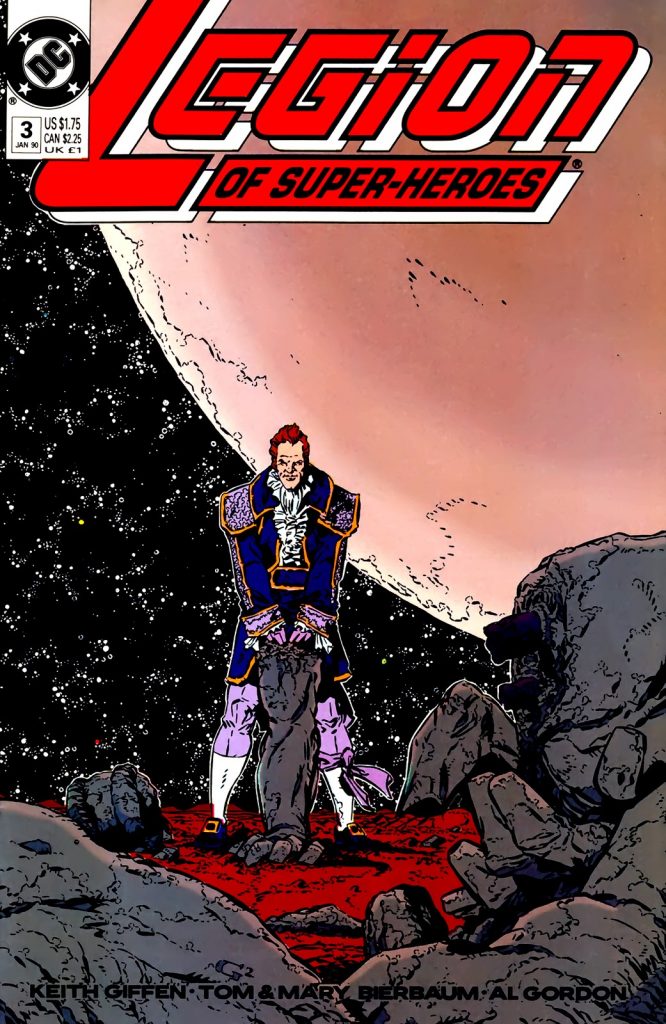
Giffen: When I took over the Justice League with Kevin Maguire and Mark DeMatteis, we never planned on doing a humor book. It just happened. And the months leading up to the book coming out were brutal for us. Brutal. DC hated the direction we were going in. It got savagely bad. Then the first issue came out, it sold like crazy and everyone went silent.
I guess it’s the way the industry is set up.
The creative team would establish their new take over the first four issues, with the former Legionnaires slowly starting to reach out to one another while genocidal maniac Roxxas was hired by the Dominators to take them out one by one. He begins in issue 3 with the last-of-his-species Legionnaire Blok, in an out of nowhere sequence that was simultaneously horrifying and beautiful.
Giffen: I knew I wanted something to let the fans know that we were not fucking around, this guy is dangerous. And it was like, who don’t I like? Blok. I don’t want to draw him again.
Boom, he’s dead.
Waid: Paul Levitz is publisher at DC at this point, and he trusts Keith, and he loves the Legion, and he’s not going to create problems for the next guy because he’s a creative person. He understands this is how it works.
Paul Levitz (longtime Legion writer and then-DC executive vice president/publisher): For several years I wasn’t reading the book because I didn’t want to be fucking around with it. That was the only fair way to do it.
Waid: That said, Paul so loved the Legion….
Levitz: The Legionnaires were both characters I loved as a kid and characters I wrote for a very long time on and off. They were kind of my adopted children by that point.
Waid: So who is Paul Levitz angry at for killing off Blok? It’s me!
I’m not in any way bitter or angry about it. I find it funny in retrospect. That’s kind of what the editor’s job is: creative people get the credit, and you get the blame.
Suddenly at the end of issue four the creative team wiped out the book’s entire timeline, replacing it in issue five with a different set of characters living in a medieval-style galaxy controlled by the sorcerer Mordru. The move read as audacious from the outside, a signal to readers that in this book, you truly will never know what is going to happen next.
But on the inside the story involved a different set of surprises.
T. Bierbaum: We literally had scripted and Keith had penciled about half of issue four. And at that point (we received) the instruction (that) we have to stop using Kryptonian elements in the storyline.
Giffen: One day I come in and Mark Waid says we have a problem. The Superman group are not fond of what you’re doing with the Legion, so they don’t want you mentioning Superman or any of the Superman mythos characters in the book. And I thought, “Really, we’ve got a book about a group of characters that were inspired by Superboy and now I can’t mention him anymore?”
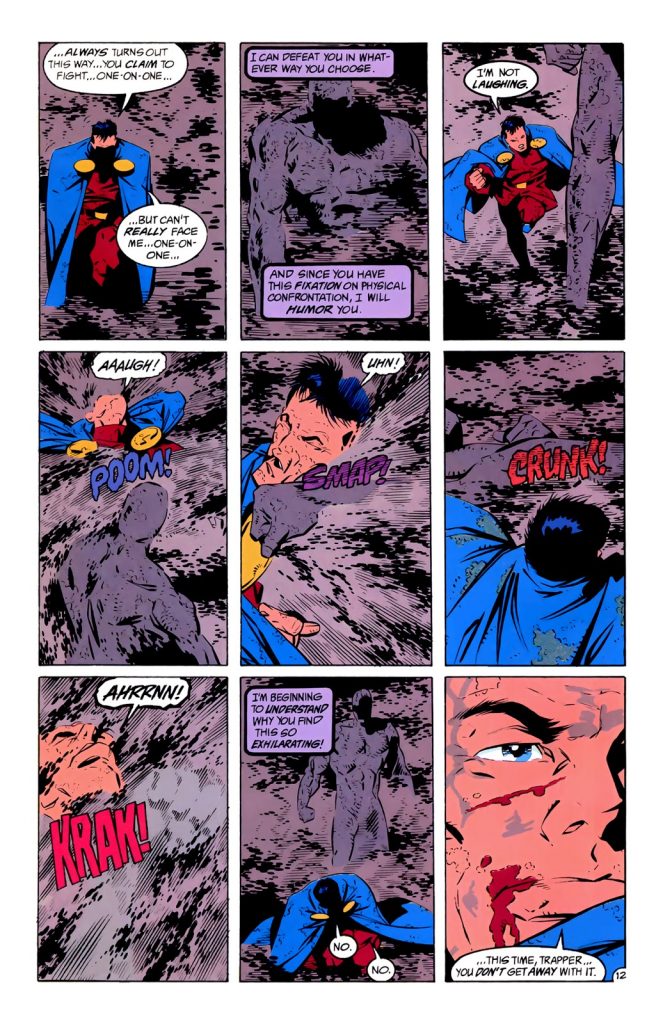
Waid: It wasn’t just Superboy and Supergirl. It was all things 20th century. Having Superboy and Supergirl carved out, even though Paul had previously done a nice explanation for how they could have existed, that was the first stage. 8 Then the Green Lantern Corps, the Thanagarians, all of that was stage two, you can’t touch any of that stuff.
Mon-El became stage three. The Superman office said Mon-El is no longer tied to the Superman universe in any way, shape or form, and you can’t call him Mon-El any more, because he has the same last name — “-El” — as Kal-El and therefore people will be confused. Which was ridiculous. But they held the keys. They were driving the car.
It was a death by a thousand cuts.
Gordon: We were pretty pissed.
Dan Jurgens (then-writer/penciller, Adventures of Superman): There was never any problem on our part with the creative direction of the Legion. Long before we got there it had been determined that Superman had never been Superboy. That compromised the Legion, so they came up with the Pocket Universe solution, which was far too complicated. Compromise efforts like that rarely work well. So it wasn’t that we weren’t happy with the direction of the book. It’s that we weren’t happy with the concept of a Superboy existing when we were doing books that said, very specifically, Superman had never been Superboy.
Gordon: It seemed strange that people working on a book that was changing the original ideas of that book would be mad that we were doing something (similar). And we weren’t rebooting anything, we were just saying it’s five years later.
Waid: I’d been an editor for like 18 months. If a more seasoned editor had been in charge they could have stood up to it. I was eventually told to my face when I tried to protest, “The Legion is to have no more connections to present-day DC continuity at all, under any circumstances.”
Giffen: I never understood where it came from. It was office politics at its most petty. And I don’t put the blame on anybody for that. I’m not saying anybody was petty. I’m saying the office politics just in and of itself, just the way it exists, is normally petty. And it just affected me directly.
M. Bierbaum: My immediate reaction was, “Seriously?” and then right after that, “Well, then what do we do about it?”
T. Bierbaum: I remember Keith calling and saying, “Do you think there’s a way we could take all the Kryptonian stuff out of the past?”
Giffen: I was frantically trying to alter things. I needed an issue that sat by itself.
T. Bierbaum: The next day, I had to drive thirty miles for work and for some reason that day Mary drove me. And in the course of that drive we came up with this Mordru story. We were in the middle (of issue 4) where at the end basically Time Trapper is going to get killed. 9 So we’re sitting here going, Time Trapper gets killed and we have to take Superboy out of the continuity…how do those things fit together?
And you start thinking, if you kill the Time Trapper, it eliminates Superboy. Then what would happen? Mordru would take over, wouldn’t he? Because what had stopped Mordru from taking over was the Time Trapper creating the Legion.
And we realized, “This is a good story.”
Waid: It was a really smart decision. Given the cards they were dealt, that was the best way to play them.
T. Bierbaum: Mary made the most profound contribution on issues like this, those kinds of overarching storylines. We’d sit down for a half hour or an hour and come up with these ideas.
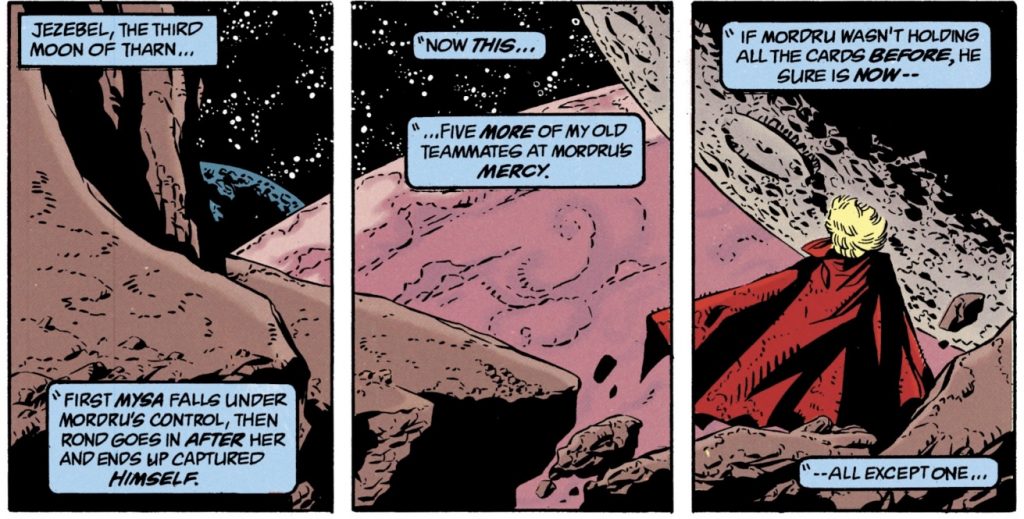
This editorially mandated change in Legion continuity would also spark the team to create a major new character: Laurel Gand, whose look, confidence and Daxamite power set all clearly echoed that of the 1980s Supergirl.
Giffen: We came back (in issue 6) and it was almost like doing the first issue all over again. I had to start establishing a lot of stuff. And the one good thing that came out of that was Laurel Gand.
T. Bierbaum: I always liked Supergirl’s presence with the Legion, but it could never really become that great because Supergirl always had her own life in the 20th century. Her relationship with Brainiac 5 was always going to be a little bit of a side note.
All of a sudden with Laurel, this character who was just begging to become an important Legion character can. She can have a complete relationship with Brainiac 5, and she has Daxamite level powers, so she’s going to be very important. And then she ends up in a triangle with (Legionnaire) Rond Vidar.
Giffen: I’ve always liked the Supergirl character. I just liked the idea of a tough no nonsense she-can-handle-it-better-than-you female character. So Laurel Gand was like wish fulfillment.
Meanwhile Mon-El was reimagined as Valor, the new inspiration for the Legion’s formation.
Giffen: It was almost like a clean slate for the character, which you think, “That’s great, I can do whatever I want.” But I couldn’t, because what about all these people who like Mon-El and followed Mon-El and now you present them with a completely 100% new character.
It was such a bitch.
Valor’s new backstory would also become an opportunity to explain how it is that every world in the 30th century seems to be populated by people with a super power.
TB: The challenge was to establish why there is this great legend of Valor, what did he do in the 20th century that made R.J. Brande say, “I want a Legion full of Valors.” Mary and I came up with this general idea of this big invasion by the Dominators and he turned them back. That’s pretty good. But is that enough?
Through the course (of his work in other comics) Keith had put in place humans having a metagene that expresses superpowers, and that the Dominators are trying to exploit that and create their own races of super warriors. So here are the Dominators doing these experiments expressing superpowers in humans. Mon-El (freeing them and) populating these sentinel worlds with them just made sense. That became the explanation for these planets full of super powered people.
McCraw: The sudden change of direction early in the series from the Superman camp made things a little erratic in the beginning and some very tight deadlines were created. But in the long run, it just showed how well the team worked together on getting things quickly back on track.
T. Bierbaum: I think a lot of the best stuff we did resulted from us being thrown these incredible challenges that we had no anticipation of and at first blush seemed impossible to work around.
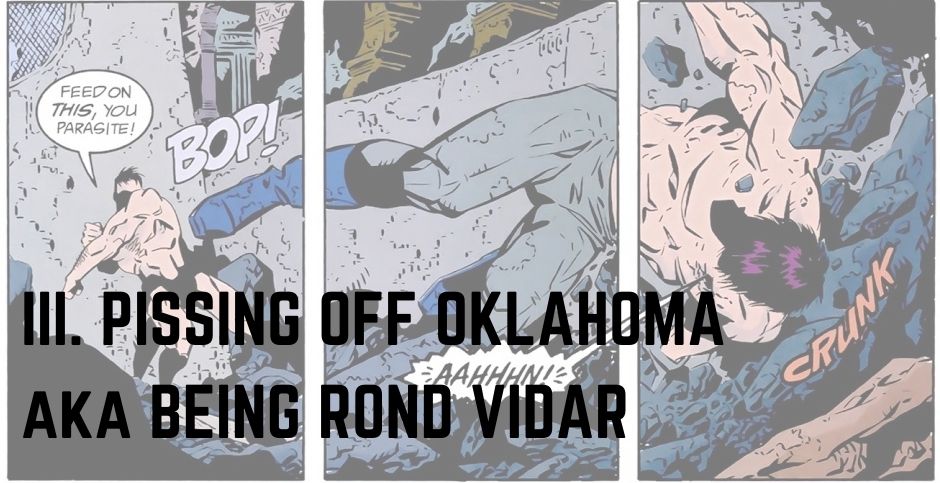
As the first year came to a close in a horror movie-scary sneak attack by Roxxas on the finally reunited Legion, the creative team found itself both celebrated and criticized.
T. Bierbaum: For the most part, the people we knew well in Legion fandom were not embracing the series that much. We weren’t exactly hitting home runs as far as they were concerned.
Giffen: From day one I was getting a lot of negative feedback from fans, but it was tempered by a lot of positive feedback. People who came on to the Legion of Super-Heroes clean, with no knowledge of Legion history, tended to love the book.
Gordon: We used to get shit from fans who were saying, “You destroyed my golden universe, my golden future.” And we said, human beings are at their best when they’re at odds in their life. They’re at their best when they have to prove who they are.
Giffen: I don’t know if it still is now, but Legion fandom was probably the loyal-est, most opinionated, most vociferous fandom ever. And I used to like that the fans were that involved in the book. But I’ve never had that kind of fan reaction on any other book I’ve ever done, up to and including Justice League International.
T. Bierbaum: I think there was a little bit of naïve hope that they would just all be ecstatic and really get into the spirit of what we were doing.
Waid: You had to have a Ph.D. in Legionology to recognize the characters. Their code names weren’t being used, and when you did see them they were half in shadow. If you bought Legion because you liked bright shiny costumes and bright shiny futures and optimistic stories, then this was not the book for you.
Giffen: The whole idea of my Legion was to drop characters into the worst situations I could think of and show how they were strong enough to redeem themselves.
Idiot that I am, I thought that I was honoring the Legion (by doing that). It was never a matter of me coming in and going “Yeah, I’m going to change everything around and piss off some guy in Oklahoma who really liked the White Witch.”
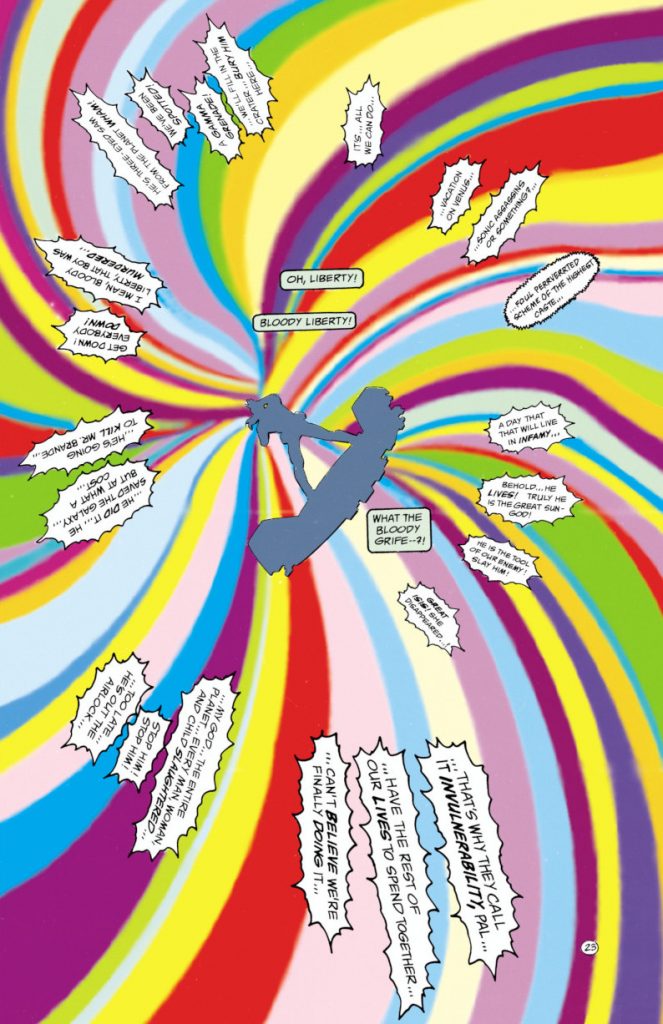
Waid: I think what a lot of people at DC were expecting from Mary and Tom was someone a lot more traditional to sort of counterbalance Keith’s wild tendencies and love for byzantine plots and his disregard for actually explaining what’s happening. (laughs)
Instead, they got co-writers who were just as byzantine as he was. And that’s what gave the book its magic and its flavor, but I can also see how some people were turned away from it because it was such a deep dive and such a challenging book.
T. Bierbaum: We would have been shy about being too assertive. It was Keith’s book. He’d earned the right to be the author of what that series was. We were going to be diplomatic.
But I also think Keith was on the mark 98% of the time. The theme that he was pursuing was that no matter how dark the universe, the spirit of the Legion, the positivity of the Legion was fighting back and ultimately triumphing. And that’s the whole magilla. He doesn’t really need us to do too much if he stays true to that course.
Giffen: There were a couple things where Tom would say, “Ooh, really? Ahh.” And I’d have to rethink it.
T. Bierbaum: In issue three, I believe, we find Rond Vidar being literally eaten alive by this mystical creature that Mordru has conjured up. And when we first got the pages, Keith said, “This is Rond Vidar being killed.” And Mary kind of let out a yelp. Mary is quite fond of Rond Vidar. We talked Keith out of killing him. And Keith said, “That’s even better. Mordru is torturing him by repeatedly eating him alive and then starting the process over.”
Levitz: Keith is one of the really great imaginative talents of my generation. I always felt that he was such a generative force. 30% of his ideas were absolutely brilliant, 30% were things that you could shape into something that was fun for whatever was going on, even if it wasn’t exactly what he had in mind. And the remaining chunk, somebody should have stopped him from ever having thought, much less putting it in print.
T. Bierbaum: This is an observation that J.M. DeMatteis made: when you work with Keith, you spend a great deal of your time trying to keep him from going off a cliff. You’re like, Keith wants to do something and you know it’s insane, and you yank him back and you yank him back and you finally talk him from going over that cliff.
And then Keith goes, “Yeah, but look how close you got to the cliff. And you would never have gotten there if I hadn’t pulled you.”
Every time there was a sense, “Are we pushing too hard?” Keith would say, “You know what, if people have to work a little harder to read a comic book, that’s not terrible.” He just really didn’t see anything wrong with challenging the readers. And so it felt like we had the support to not spoon feed anything, to try and make every page and every bit of dialogue as genuine and organic as we could make it.
Giffen: I thought, let’s let sales on the book tell the story. If this book nosedives, I was wrong, and I either change it or I let someone (write) who’s more in touch with whatever the zeitgeist was out there.
Waid: There was never any thought of firing Keith or canceling the book or anything like that. Nobody thought it was unpublishable.
But everybody was looking at it to be like Justice League #1, and it was as far away from Justice League #1 as you could possibly get tonally and structurally and in terms of craft. Everybody was doing their best on that book, and I still think that stuff holds up. But if you were expecting Justice League #1, this is not it.
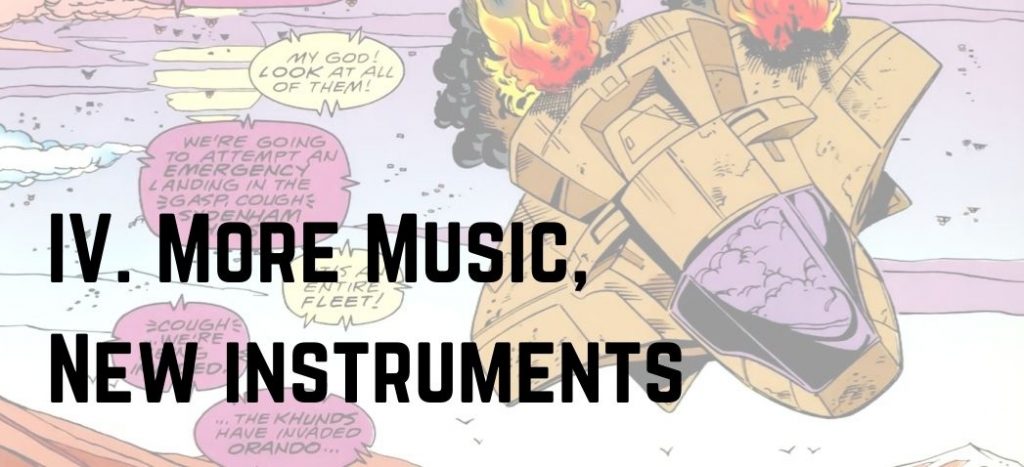
Where the first year of the book had been about establishing the universe and team, the second was characterized by a refusal to play it safe in favor of new ideas, new characters and new opportunities for its creative team.
Giffen: During my entire career I’ve never outlined, I’ve never planned. It was always, “Oh, what’s the next issue? And what’s the issue after that?” So there was no grand scheme or plan to the book. It was just “Okay, I’ve got another issue to do, I think I’ll do this, I think I’ll do that.”
Waid: Keith is exaggerating a little bit. Basically it’s like you’re in New York, you know you have to drive to Los Angeles. And we start going and Keith throws the road map out the window. We still know basically where we’re going. That’s why it holds together. It’s just that Keith is playing jazz all of a sudden. We’re trying to do a symphony and Keith is playing jazz.
T. Bierbaum: Most creators would have sat down (and planned) to get to a certain point by issue ten and a certain point by issue 15 and a certain point by issue 20. Keith initially had plans like that, but his creative impulses are restless. If he spends too much time heading toward that same endpoint, by the time he gets there he doesn’t find it very interesting any more.
Giffen: When you’re first on the book there’s the excitement of the new book. Then it goes into just maintaining what’s been going on in the book. And after a while you’re like, “Jesus Christ, the Vulture again?!”
Waid: A book that takes two days to write is one thing, but if you’re then the artist sitting there for 21 days looking at every single page and living with it for eight hours a day you’re going to come up with new ideas as you go.
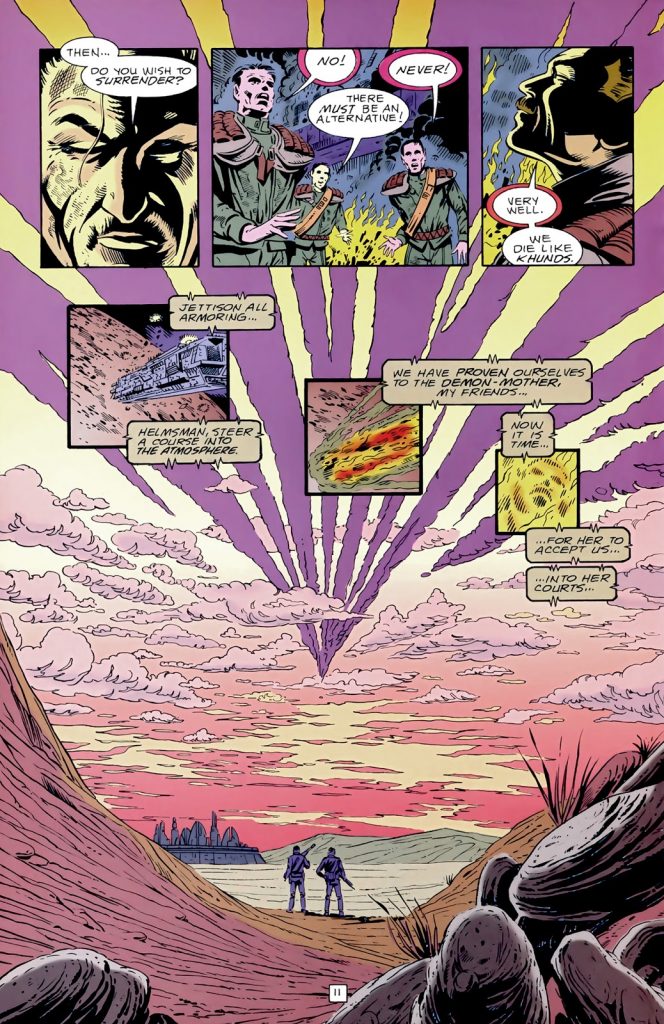
Early in the year the Bierbaums would be invited to write four issues on their own, featuring Chuck and Luornu Taine (Bouncing Boy and Duo Damsel) as the directors of a military academy on a planet invaded by the Khund, with Brandon Peterson doing pencils.
T. Bierbaum: I remember getting a call from then-editor Dan Raspler, who said, “Let’s do a war story.” It was a really great opportunity.
For us it was a theme that all of these Legionnaires are just great people. They talk about how when Vince Lombardi’s 10 players retired and went on into life, most of them were great at what they did, because they were trained by their coach in greatness, not just in being football players. I kind of envisioned the Legion characters that way; when they move on and become different things, they’re great people and they accomplish great things. So that was something we were determined to show in Chuck Taine.
Giffen: Brandon came along and he was looking to make a big mark in comics and I thought “Okay, here you go.”
Brandon Peterson (penciller, issues 15-18, Annuals #2-3): My first full issue work was these Legion issues. I wasn’t even (finished with) college, I was beginning my Junior year when I got the first issue of work (#15). At that time I was a full time student, with a part time job doing the graphics and layout for the college newspaper, and drawing monthly issues. I basically just ate, worked, went to class, and slept about six hours a night. I turned 21 during all of that flurry of activity and didn’t even bother to have my first legal drink until about 2 months after the fact.
T. Bierbaum: Baptism by fire is probably the operative phrase. He was just starting out on his career and was given a couple of the most challenging assignments of the book with the war, every character you have ever heard of and all the different worlds. And he did so well with them.
Sometime later he also did one of my favorite stories, the reunion story in the third annual. And again, his pencils were such a home run. He made you feel the setting and the warmth between the characters.
Al Gordon would also write his own four-part story, The Quiet Darkness, a follow up to one of the most popular comic stories ever written, The Great Darkness Saga.
Gordon: I kept coming up with stuff, I’m sure I was a complete pain in the ass, I was calling Keith like every third day and saying what about this. And at one point Keith said, “I’m getting tired of competing with you.” I said, “What are you talking about?” He said, “Well you’re coming up with good stuff, and my natural inclination is to come up with something better.” Which is something he was remarkably good at. I would come up with something and Keith would go “Well, what about this?” and we’d throw things back and forth. It was just a really remarkable collaboration.
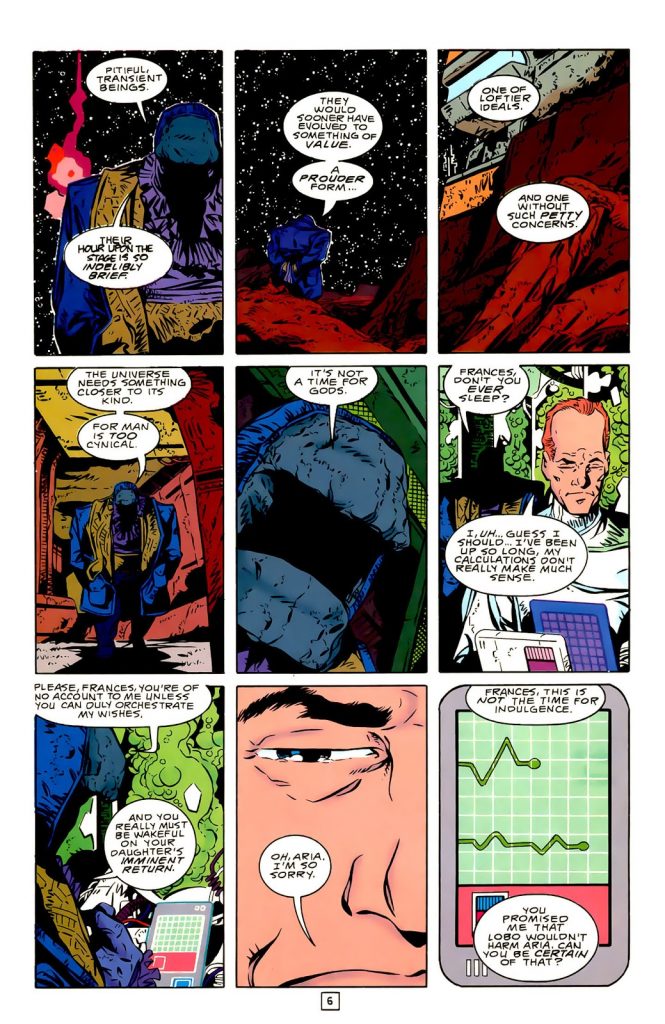
And Keith said to me, “Why don’t you write four issues?”
Giffen: He said he had an idea for a sequel to the Great Darkness Saga. I said “Good, I don’t want to do it.” He had to talk me into it.
Gordon: I remember thinking we’d just do it like we’d been doing it. I called him and walked him through (issue one). He said, “Great, when can you get me a script?” I said, “I just gave you the script.” He said, “Fuck you, write me a full script. And I don’t want any amorphous bullshit, write me a script panel by panel.”
I didn’t even have a computer. I wrote everything down on a yellow legal pad.
The story features a group of Legionnaires trying to save a child from Darkseid, who seems to have some terrible plan for her and her twin brother, only to reveal in the end that he is trying to use them to bring about his own death.
Gordon: I remember joking with Keith, when you’re the epitome of the ultimate evil in the universe, it’s got to be boring. Evil, yeah, been there, done that. Who the hell cares?
And (my thought was), Darkseid was just absolutely bored with being the bad guy. I saw him as an old, bored Orson Welles. He was tired of being the guy holding up the other end of the scale and he was looking for a way to die.
T. Bierbaum: It’s a really ambitious and well executed story. I think the biggest compliment that the fans paid to it is that people said it was an appropriate way to wrap up the entire storyline, the entire existence of Darkseid. (And it did so) in a way that defies all the rules of what a comic book story is supposed to be—the action-packed ending, over the top drama.
Giffen: It turned out to be a great story. It was all Al.
Giffen’s empowerment of his creative team would extend beyond his co-plotters.
Giffen: Here’s a thing about me. I don’t think in color. I don’t dream in color. I have no color sense. So when Tom (McCraw) was working on the book, it was coming along great, and I was saying just keep doing what you’re doing. Every so often I’d say, “Oh this character should have a purple tunic on,” but that was really rare.
McCraw: Both Keith and Jason 11 were great to work with. I loved both of their art styles. They gave me minimal suggestions, unless they wanted something specific on a character or the mood for a certain scene. Otherwise, they left me on my own to create a colorful world for the series.
Workman: I stole something that Carmine Infantino and Al Williamson and various people would do occasionally, and that is the breaking of the border with the word balloons, especially toward the top. It would open up things and move the balloon up a bit off the artwork.
It could also make the whole page more interesting. You can give the page something of a 3-D quality because you’ll have different balloons on different layers…maybe one behind a person, and then another in front of that person. I like to lead the reader’s eye around to where it has to go.
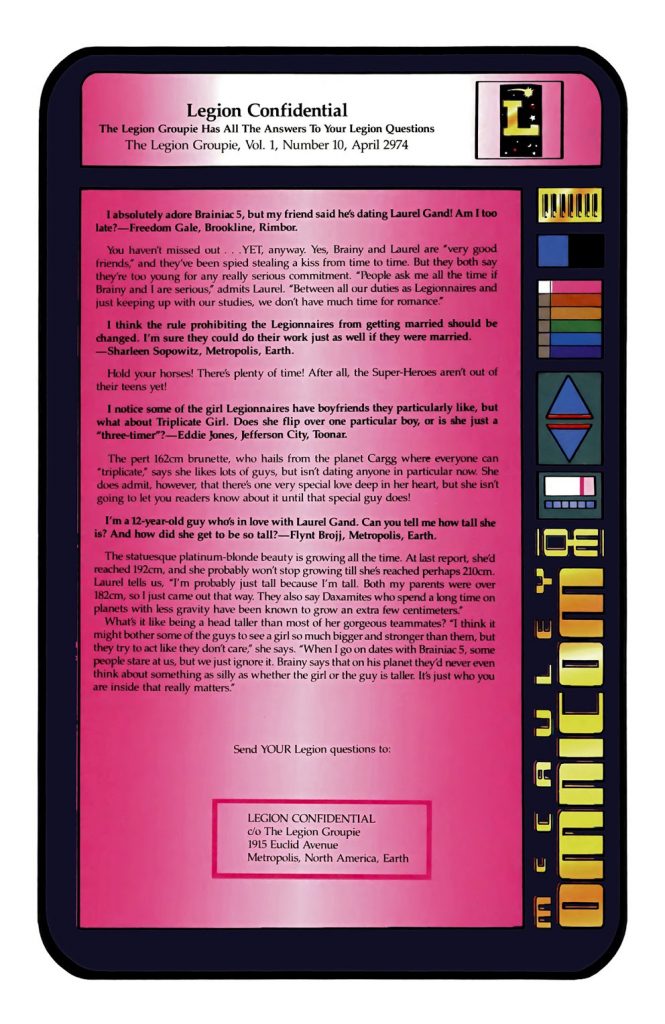
T. Bierbaum: It was Keith’s idea that we do the text pages. 12 It was partly Keith’s generosity; on a standard page he’d get his penciling rate and his plotting rate. If we did a text page instead, we got the full pay for that page.
It became what Keith wanted to use when he got to some big piece of background that needed to be explained but that would be boring to do within the story. As a person who at that point was working full time as a reporter, I was pretty good at making fake news articles sound like real news articles.
Because another strength of ours was dialogue, we could also do things like transcripts of TV or radio broadcasts. It was a way to be inventive, to try to express the characters as much as we could from different angles.
Waid: We were trying to figure out how to do those text pages, what that would look like. What kind of communication devices would the Legion be carrying around? Remember this was 1989. There’s nothing even remotely like [a smartphone] at the time.
And art director Richard Bruning basically invented the iPhone twenty years ahead of its time. He said, “Yeah, we’re going to call it the Omnicom, and it’s going to be this thing that the Legion carries around, and it’s going to have text on it and voice and all.”
Richard Bruning (DC Art Director, 1985-90): Wow, I had forgotten all about those. Yeah, I think I did do them. I appreciate Mark noting work I don’t even remember doing, though it was 30 years ago!
T. Bierbaum: I think of our creative team like my favorite group, the Beatles. Keith is John Lennon in being kind of the leader of the group, the one with the most avant-garde sense and the most determination to be challenging. Mary and I are kind of Paul McCartney in that we’re kind of eager to please in a traditional way, a little less rocking the boat. Al is sort of George Harrison, a little more ethereal, his themes a little more ambitious and a little less straightforward.
And then for Ringo I’d include everyone else: Tom McCraw’s brilliant colors and all of the letterers. There were times that the Beatles wouldn’t let Ringo use the same instruments two songs in a row. We did the same to our poor letterers, always coming up with some new different thing that popped into our heads. And over and over they came through and managed to take these goofy ideas and add texture to the overall project.
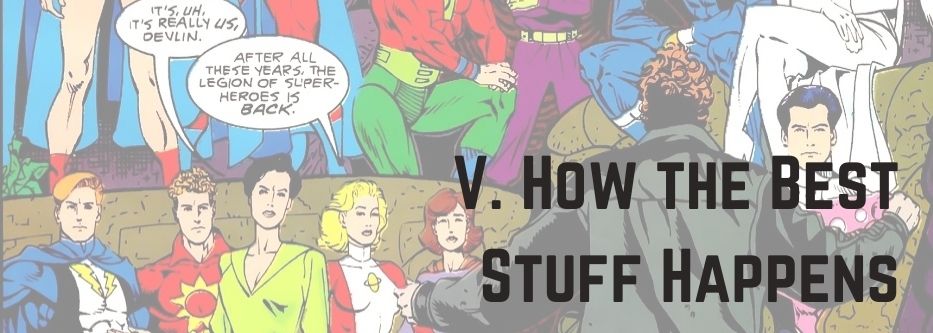
The second year also saw the detonation of the moon via a Dominator-planted bomb as part of a time-travelling-Superman crossover, destroying it and initiating the internal war for control of Earth.
T. Bierbaum: I think it was something Keith thought would really shake things up. And we were really wanting to be accommodating to the Superman people because of the issues earlier that had led to them saying don’t use our mythos.
Giffen: I wanted somehow to get across the feeling that nobody is safe. It’s a war. Anything can happen. Who the fuck at the start of World War II saw us taking out Nagasaki? Things change.
T. Bierbaum: It really did change the tenor of what’s going on on Earth and accelerated the slide into open warfare.
After having ranged widely in location and style, the third year was a big shift yet again, offering a twelve part series focused almost entirely on the step by step chess match between the Dominators and resistance fighters for control of Earth.
T. Bierbaum: Each issue you go further down the line, and what comes next becomes more and more inevitable.
Giffen: I like the Dominators as villains, because it’s a culture. It’s like well, if you defeat the big Dominator on earth, it’ll be over. No, you have to defeat the whole fucking planet.
Another substantial change in its final year was artist Jason Pearson stepping in full time to do pencils over Giffen’s layouts, as carrying multiple roles on the book began to weigh on the veteran writer/artist.
Giffen: I’d worked with Jason before on a project and I thought if he’s interested, he’ll have a really interesting approach. I’ve always been a huge fan of new talent. I think it adds a new approach to doing a book, different visual things, and it keeps old farts like me on our toes.
T. Bierbaum: It was just a smart thing to do. We were asking too much of Keith to plot, layout and pencil the book. And Jason did beautiful work. He really worked hard to inject creativity into what he did.
And the year would bring some of the series’ most notable beats, starting with the establishment of a completely different and highly unexpected group of Legionnaires as Earth’s saviors.
Giffen: The first time I ever plotted the Legion was that one Legion of Substitute Legionnaires special. And that’s what turned them into a joke; they were pretty much made fun of.
T. Bierbaum: To this day if the subject comes up (in Legion fandom) you’ll get an earful about how terrible it was that Keith did that.
Giffen: The one thing I was determined to do was to make them a cool, valid group. After having taken them and turned them into laughing stocks, I thought I’ll turn them into the Howling Commandos of the 30th century. (Of all the Legionnaires of Five Years Later), the only group that held it together and became a very effective underground resistance group is the goddamned subs.
T. Bierbaum: It was a great deal of fun to see those characters come into their own. And it felt like Keith was really developing (their) personalities. In the past, I could tell them apart by the color of their uniforms and their powers. But as Keith was plotting it out they were really becoming individuals. That was really a big accomplishment.
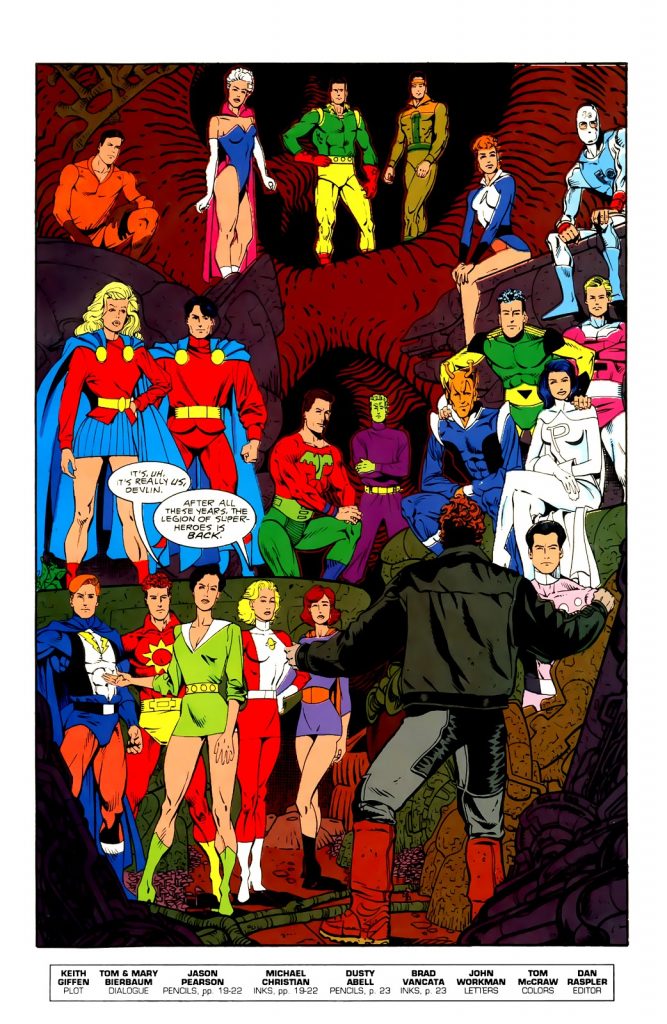
In maybe the biggest twist of the series, a second group of new Legionnaires was also introduced — Dominator-created clones of the original Silver Age team.
T. Bierbaum: My recollection is that very early on, maybe about a year into the run, Keith called and said, “What if we do an issue, an issue, where a version of the early Legion shows up and they have a big fight between the two Legions.” It sounded good to me. But once that idea came up, the possibilities started becoming pretty attractive. Why limit it to a single issue? Keith started thinking of it as more an ongoing subplot. We were fine with that.
Giffen: It was just this constant hum in the background, “This isn’t our Legion, this isn’t our Legion.” It was like, “Okay, I’ll give you your Legion.”
T. Bierbaum: I think there was a sense that we’ve really pushed the envelope in terms of what the Legion can be, and some people are really onboard with that and some people are saying this isn’t what I’m used to. And I think it began to feel right to Keith to do this ambitious approach and also have a piece that is the original early idealistic approach.
Giffen: People accuse me of bringing in Batch SW6 13 to prove my point that (the old) Legion doesn’t work and mine does. That was never my intention. It was interesting to me to deal with Jo Nah in my world and then deal with a Jo Nah who is still the tough but slightly innocent kid from Rimbor.
T. Bierbaum: I was pleased that we didn’t say “Oh yeah the Silver Age heroes, they’re all dorky.” Yes, there were moments they did things they shouldn’t have done. You can’t go march out there in the open (in a warzone) and salute the Legion flag. But they learned very quickly and were very effective.
In fact, while the Five Years Later Legion was mostly trapped watching the war unfold from afar, Batch SW6 would join the Substitute Legion in defeating the Dominators, with three of them dying in the process.
Giffen: You can’t have something that big without consequences on both sides. You can’t end it with a bunch of dead Dominators and the Legion singing la la la. In war, nobody walks away from it untouched. Sometimes it’s tragic, sometimes it’s positive. One of the stories I’m most proud of was the story of Venato Bay — how two people who were friends and allies can wind up on opposite sides, and how things can get taken to the point where it goes really, really wrong. After the action is done, there’s the repercussions.
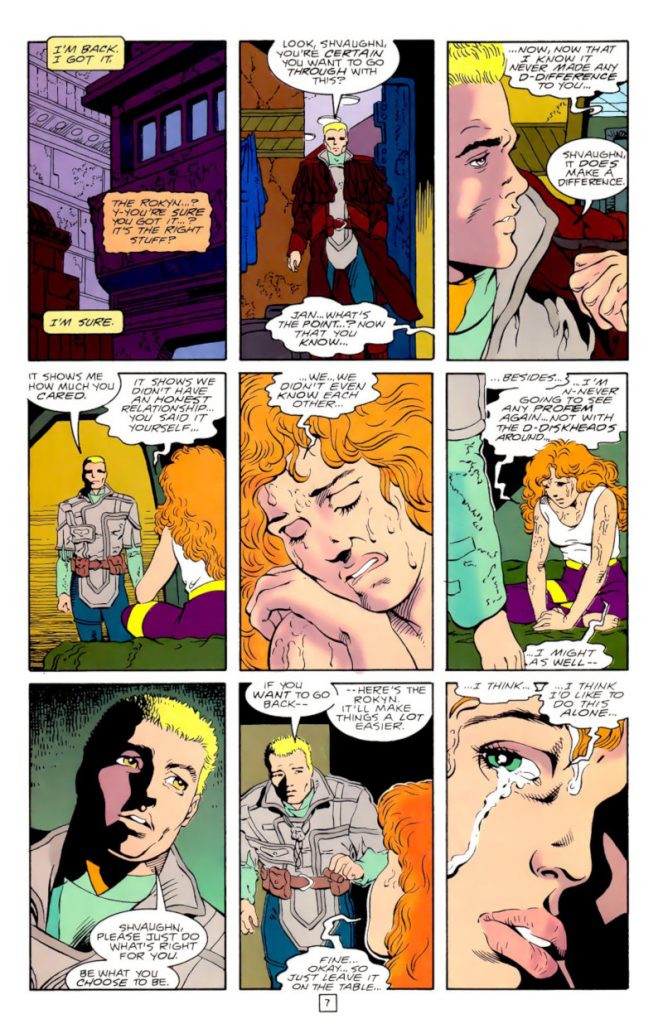
In the midst of the war, the book also produced the shocking reveal that Science Police officer and Legion friend Shvaughn Erin had changed her gender years earlier via over the counter drug Profem to try and win the love of Legionnaire Jan Arrah (Element Lad). This decision had a mixed reaction at the time, and its positioning of Erin as someone who swapped genders to gain Arrah’s favor has made it one of the most controversial story beats from the run. 14 It stemmed from a prevailing fan theory Giffen wanted to address.
Giffen: The Legion fandom had some really interesting theories. Fans would argue about whether Element Lad was gay all the time. I figured fine, let’s do a story based on that. But he’s with this girl, so how do I figure that out?
Gordon: The drug idea is mine. In my mind her planet didn’t ascribe their gender until puberty, then she took on being a male, and then decided (later) that she had made the wrong decision. But I think for the most part everybody thought she was human, so none of that really got applied.
Giffen: Profem was one of the cool things about the book. It’s the 30th century: if you wanted to do something, all you had to do was think of something. It was such a vast playground to work in.
Levitz: A lot of Keith’s strength was his ability to think as a real science fiction guy. He could look at existing technology and look ahead to what he thought it might be. He built a real feel to the future he was working in, which very few artists are capable of doing.
Giffen would leave the book with issue 38. Had he stayed, he had another enormous twist in mind for both sets of Legionnaires.
Giffen: Everyone was like, “Which is the real Legion, is it this Legion or Batch SW6?” And I thought, “What if (the 5 Years Later) Legionnaires really aren’t the Legion?”
I decided our guys were going to be the clones or a manipulation of some kind. The two groups were going to get together and free Earth from the Dominion, five Legionnaires were going to die–I swear this is true, I was going to pull all the Legionnaires’ names in a hat and just pick out five names 15 — and then afterward Batch SW6 would take over Legion of Super-Heroes, so the fans would get the Legion they loved back.
T. Bierbaum: My recollection was the first time he ever said that to us, we said that there were four or five characters that didn’t really make sense if the kids were the real ones. As far as I knew the idea was dropped at that point. But I’ve heard him say in interviews that was absolutely his plan.
Giffen: I was going to leave the book and start a new book about my Five Years Later group out at the farthest reaches of United Planets Space. They would be the last line of defense for whatever is coming toward the (United Planets) space –the last line, the “Omega Line”. And it was going to be called Omega Men.
What kept Giffen from going forward with this storyline was not a lack of interest on his part but continued struggles with DC.
Giffen: By that point there was constant pressure on the book to change things back. It was this very vocal group at DC saying, “You shouldn’t do this, you should change (it) back.”
Gordon: We would pitch something to them, they would okay it, then we’d do it and they’d read the book when it came out and say, “What did you do this for?” And we’d say, “You already read this, we didn’t make any changes.”
Giffen: There were people that were openly scornful of the book, and they had every right to be openly scornful of the book, but it was just constant. I thought, “There are so many other books at DC I can do, why am I agonizing over this?”
So I said, “Okay, you want the Legion your way? Boom, here you go, Earth’s gone. Fuck you, I’m leaving.”
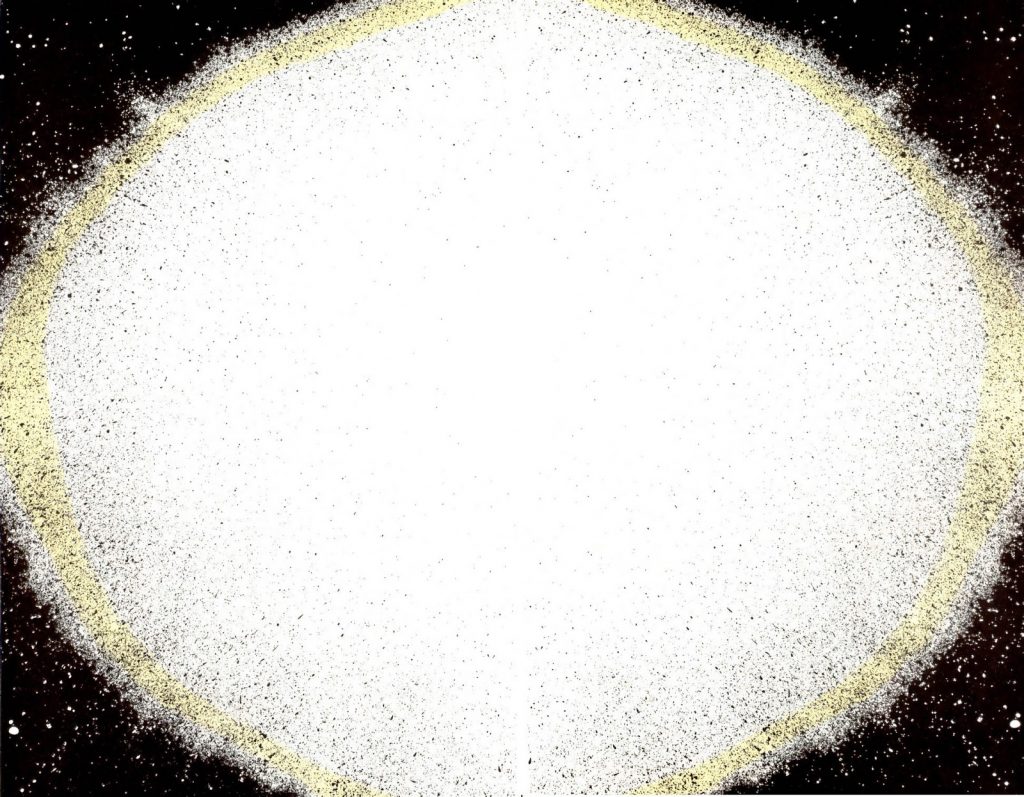
Giffen’s final issue on the book would reveal that the damage done to Earth from the Dominator occupation combined with centuries of human mistreatment had initiated a rapidly escalating planetary collapse. As journalist Devlin O’Ryan’s poignantly narrates the events, the planet’s population attempts to flee. Those who survive watched the Earth explode from space.
Giffen: That’s how blowing the Earth up came about. It was just spite. People were talking about how they’ll revise the book, and (how they were going to ignore) all the stuff I had done And I said, “You’re going to be that way about it? Fine.” And I blew up Earth.
T. Bierbaum: It was the most daunting assignment we’ve ever had. It’s a landmark event in the entire history of DC, and the entire thing is told through the words that we put into Devlin’s word processor.
It was adroit of Keith to put Devlin in that position. The original concept of the character was that he would inject some of that Silver Age optimism and idealism into this darker universe; the heartbreak of that issue is felt all the more keenly for somebody who has optimism, who thinks that the world is supposed to work, that things are supposed to end happily.
Giffen: In hindsight I can say, “Yeah, I probably stepped over the line.” But then, you know, that’s how weird stuff happens. And that’s how the best stuff happens.
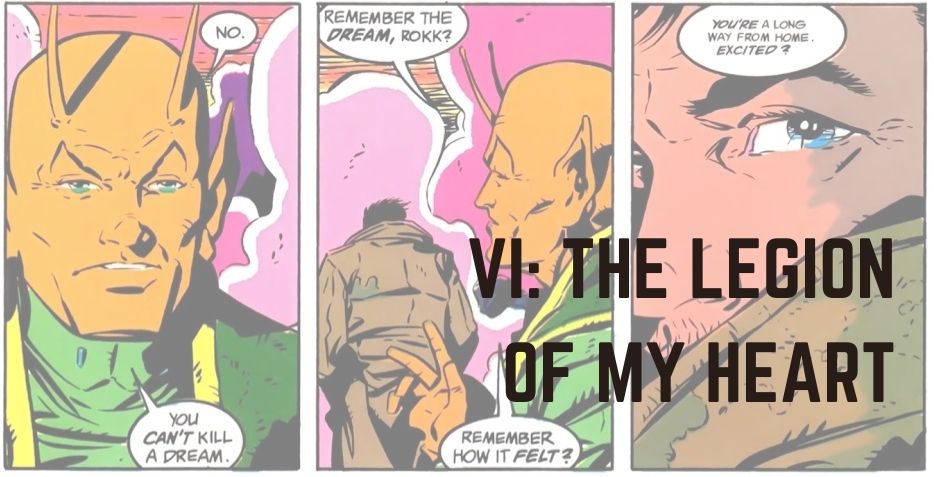
When Giffen left, Gordon had already been gone for some months. His work on Legion had gotten him a new job writing a Timber Wolf mini-series. The Five Years Later run would continue without them both, written first by the Bierbaums —alongside a spinoff about the clones called Legionnaires — and then by Tom McCraw. But the mandate had changed.
M. Bierbaum: When we learned that Keith was leaving the book and we’d be taking over plotting, there were mixed emotions. We’d miss working with Keith and didn’t really feel like we had a lot of support at DC over the long term.16 But it was also exciting to start thinking about what we could do with the stories going forward and a lot of fun to start charting the course for all these characters.
T. Bierbaum: It was daunting. We knew we weren’t going to do the things that Keith did. And the editors felt the challenging level of the book was limiting its appeal and wanted to do something that was broader. I think we felt up to the task. Every time we got a chance to plot our own stories we relished it.
I think probably we could have accomplished more if we could have felt we were really in it for the long haul. It was really just telling contained stories rather than continuing to try and weave a long-term tapestry.
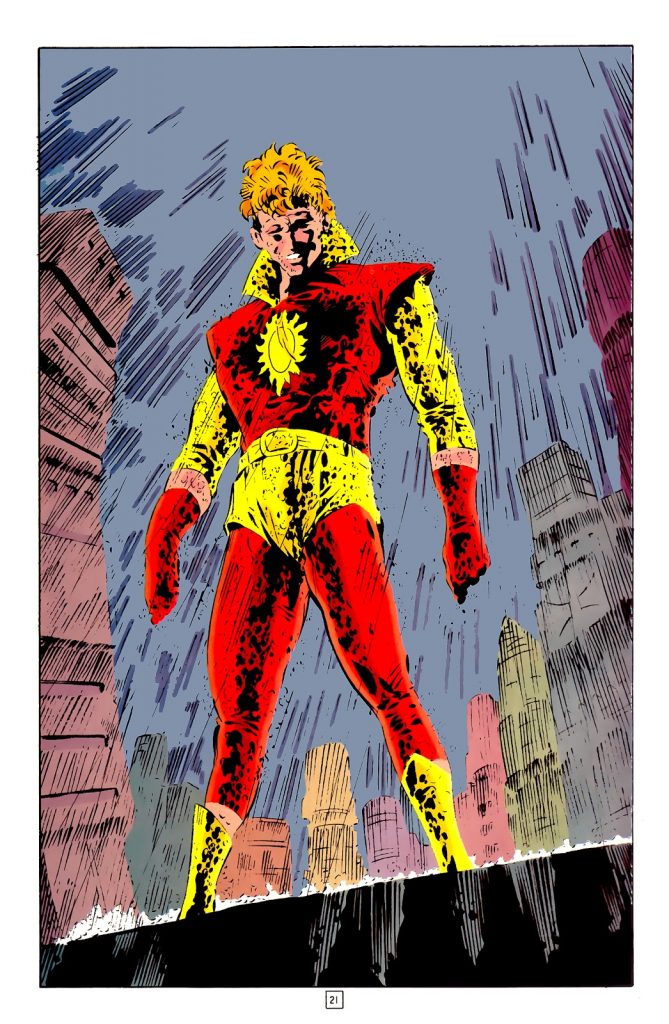
Looking back now, over thirty years later, what they all end up talking about is their fondness for each other and their collaboration.
Giffen: After a while on the Legion, I really think I became the least important aspect. When you’ve got people who are solid professionals and will take care of their own business, you can relax. It’s a cool feeling to be on a book because you want to be, not because you feel you have to be.
T. Bierbaum: You had these different creative forces with their own voices. Each of them can tell their own stories, but together there was a synergy that I thought hit some real high notes.
Gordon: I was really taken by Tom and Mary’s ability to reach into your chest and play with your heart. I spent most of my life being like Jo; I don’t like showing emotion. They helped me feel comfortable writing the stuff I like and hoping that it didn’t come off as being maudlin.
T. Bierbaum: I’m not really an innovator. I’m kind of timid and don’t take big chances and stick with what’s worked. Keith is not that. When he works with you, he challenges you. He makes you want to try harder and stretch further. It was exhilarating.
Gordon: Keith could pull ideas out of a vacuum and turn them into stuff. He’s always been this incredible talent. It was so much fun working with him. He would needle you until you came up with something better. He was a little older than the rest of us. He was like the older brother. You want to do good by your older brother.
T. Bierbaum: One of the things that I valued so much about Keith and many of the other artists we worked with is the emotion the characters are exuding. When the emotion is there in the expression, you can understate the dialogue, and you start feeling like these are real people.
Giffen: Everyone was on the same page. We never had hassles bubble up internally. They were always brought in from outside, and we just circled the wagons. We stuck together.
Peterson: I couldn’t have asked for a better group of people to get into comics full time with. They were all so encouraging and available. I would call them all up and just talk about comics, the books we were doing, life, everything. I think they all saw how eager I was and just sort of gave that energy a good direction.
I now have 30 years of my own experience now to call upon and I can say I never worked with finer people. I had some idea at the time how lucky I was, but now it’s obvious I couldn’t have asked for a better group of peers and mentors.
Workman: When I worked at DC in the 70s, there were 35 people total on staff, that included the accounting people, secretaries and such. When I was there in 88-89, I think there were close to 100, and I thought there was this kind of feeling of creation by committee.
I didn’t feel that at all with the Legion book. I thought it was a handful of people who knew what they were doing and really enjoyed it.
T. Bierbaum: I think we were very fortunate to work with Mark. He was very accepting and encouraging of what we were putting into the mix. And overall I think we had a pretty good relationship with all the editors, Mark and Dan Raspler and Michael Eury and KC Carlson. In retrospect, I’m quite surprised with how free a hand we generally had.
Jason Pearson (penciller, issues 22-24, 26-30, 32, 34-36, 38): Those that contributed to that time will always be a Legion of my heart.
Two years after Giffen left the run, the Five Years Later continuity was wiped out by the DC line-wide event Zero Hour. With the exception of Laurel Gand, almost none of the Five Years Later Legion has ever appeared again beyond an occasional glimpse in the background of a multidimensional crossover group shot. In an industry that seems to always resurrect everyone eventually, the group’s 30+ year absence from DC continuity is unusual. 17
T. Bierbaum: We’re not actively reading, so there’s not a sense in us of what they have brought back and what they haven’t. I have had a vague sense that we are being given a rawer deal than most of the other continuities that have existed, but I’m kind of philosophical about continuity. Continuity is just an invention. The comics that you read and treasured, those comics count for you. The comic that missed the mark, it doesn’t count for you.
For me that’s the real measure. And that’s what we deserve as creators, the chance to have the audience see what we put out there and make the judgment for themselves.
Giffen: I think that it’s never really gotten a fair assessment. I hear people talking, “Oh you did this, you did that, that was my favorite character.” And I want to say, “Okay, fine, but how was the story? Did it draw you in?” That’s the ultimate thing.
Plenty were drawn in, in fact. Among their number are some of the finest writers of comics today.
Jonathan Hickman (the X-Men line, Decorum): When I was in middle school, my friend Eric wouldn’t shut up about how amazing the Legion of Super-Heroes was. Like, every day at lunch, “I can’t believe you don’t read the Legion. You have to read the Legion. You would love the Legion.” Turns out, some guy had come (into the local comic shop) the week before and sold his entire collection, (including) a run of Legion that went from Superboy and the Legion 220-something up to when that series ended with Legion 313, and then #1-3 of the Baxter launch.
Reading all that Legion history in one giant bite was exactly how reading (Five Years Later) made me feel years later. The density of it, the velocity, the total immersion into a world that had a sort-of-familiar history and took place in a universe you knew, but it was all pushed a little further.
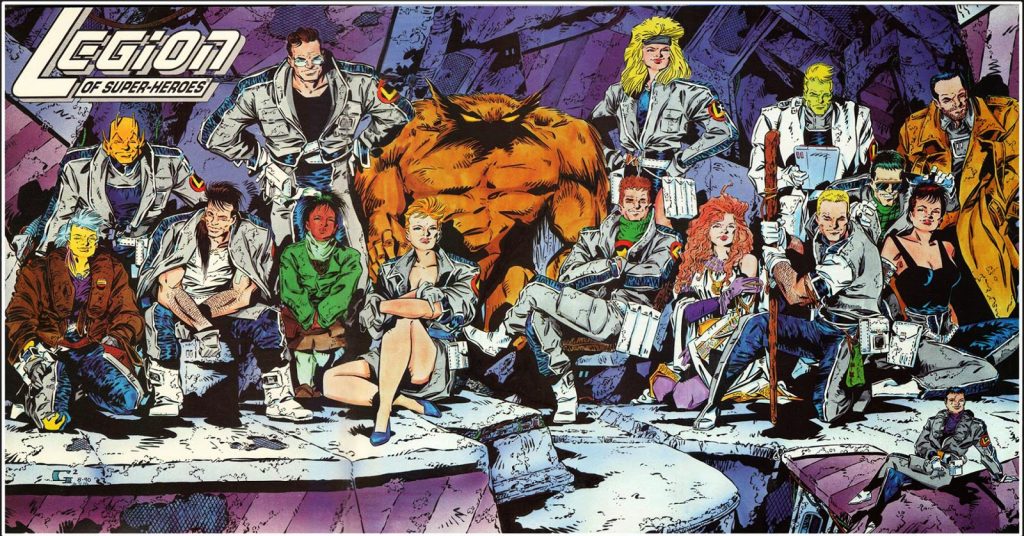
Al Ewing (writer, Immortal Hulk, S.W.O.R.D.): I was around twelve, and at that age, it was definitely hard work. I was content at first to let the ambiance wash over me, to trust that everything I didn’t know meant something, which, judging by some of the feedback I’ve had, is not something readers are as happy to do today. It was dense as anything, and I loved that. I loved not quite being able to follow it.
I’ve been trying to put Legion jackets on teams forever…And that bit in the middle of issue 12 where there’s a bit of dialogue about “we’re finally back” – after 12 issues! – and you turn the page and it says “THE LEGION OF SUPER HEROES.” I stole that. Guardians (of the Galaxy) #1. It’s right there. And I’ll do it again.
That was such a fist pump moment.
Hickman: Inside of comics, (Five Years Later) is probably the most influential book for what forms my general ethos on what a comic book story should be. I just think it was so ahead of its time and done by super-talented creators who weren’t afraid to take some insane narrative risks, and I just love it to death.
Ewing: It was so smart. It was such a clever thing to do, to just break free of the established “1,000 years in the future” thing and do a time skip. It sounds simple, but it’s just brilliant. And that first year, two years was just perfect comics in so many ways, a tour de force. I feel like they’re an unspoken inspiration for so many of us.
At the heart of the Five Years Later run lies a fierce and radical hope. No matter how bad things get or how poor are our own choices, a better world is still possible. The dream always lives on, and we help each other reach it along the way. Working on Legion, Keith Giffen, Mary & Tom Bierbaum and Al Gordon experienced the truth of that hope for themselves as well.
T. Bierbaum: We had a real fear (going in) that Five Years Later was going to be a lot of characters stumbling and losing track of the ideals of the Legion. But their valor shone through even brighter given the darkness of the universe.
I think it was one of the most heroic runs that the series has had. I feel fortunate that we were included on that team and got to participate in the vision that Keith brought to it.
Gordon: We were all very different. Legion is this amalgam and sort of an explosion at the same time. It’s this combination of four hearts and minds, and four people arguing.
M. Bierbaum: Finding out we’d get to work on the Legion was probably the most exciting thing that’s happened to us in our work lives. It was an amazing opportunity. And it was always a lot of fun, especially when we could get together with Keith and Al. We really were kind of like the four musketeers. We just really enjoyed working together.
Giffen: For all the hassles that grew out of it, all the little skirmishes with other people at DC or the fans or whatever, I still looked forward to doing it. It’s one of my favorite books to have worked on.
If I could go back in time, I wouldn’t change a thing. I’d do it the exact same way. The exact same way.
Since publication, an adjustment has been made to clarify one story point within the piece.
As penciller on the storied Paul Levitz run that preceded Five Years Later↩
AKA J.M. DeMatteis.↩
Interlac is a Legion fan organization that has been around for 45 years. It publishes a bimonthly mailing of Legion discussion and personal writings by the membership.↩
In Issue 28 the Bierbaums would lay out the pattern of parental abuse, rejection and insecurity of earlier Legion runs that had brought Dirk to his low point, while in the present he attempts to right his course too late.↩
Shakespeare was a combat medic with a distant connection to Clark Kent; Rockfish, a detective with a mysterious connection to the Green Lanterns; Kono a teenage pirate; and Devlin O’Ryan a Jimmy Olson-style reporter. Penciller Jason Pearson would later add the teleporting assassin Sade.↩
Mary was kind enough to offer a couple comments for this piece, but otherwise felt Tom could speak for both of them about their time on the run.↩
After lettering the book for the first thirteen issues (plus the first annual and issue 17), Todd Klein moved on and John Workman took over, with a few issues lettered by Albert DeGuzman and Janice Chang.↩
John Byrne’s 1986 Man of Steel mini-series reconceived Superman’s origin without a period as Superboy. Byrne and Levitz’s fix was to reveal that the Superboy the Legion knew was from a pocket universe created by longtime Legion foe the Time Trapper.↩
By Mon-El, who sacrifices his life to stop the Time Trapper once and for all.↩
The legendary Green Bay Packers’ head coach from 1959 to 1967.↩
Pearson, who would come on as penciller over Keith’s layouts.↩
Starting with the first issue the back of most issues would feature multiple pages of news stories, diary entries and other text-based storytelling presented as though on some kind of mobile device.↩
The Dominators had multiple “batches” of cloned super-powered people in storage waiting to be activated. “SW6” was their designation for the Legionnaire batch.↩
As Charlotte Finn covered at length for Comics Alliance back in 2015.↩
The “Giffen pulls names of Legionnaires to murder out of a hat” story is the stuff of legend amongst the creative team, with different members telling different versions. In one everyone but the five names pulled out would die. In another Blok died because he was the name Giffen pulled out of a hat.↩
In fact DC informed them they were talking to other writers about taking the book, until the Bierbaums reminded them they had a contract for another year.↩
As part of its recent “Omniverse” continuity refresh, DC is now embracing all its former stories as in continuity. So there’s actually nothing to prevent the Five Years Later characters from appearing again, or even a new Five Years Later title from now happening.↩
